Painter Hernan Bas is known for unabashedly dabbling in the glittery realm of cliché, populating his work with red roses, flamingos, and most recently, fairies, as a whimsical retort to the perpetual tag of neo-romantic, Miami-based, gay artist. It only makes sense that since relocating to Detroit, paintings once read as decadent are now being labeled portraits of decay. It’s true that Bas’ work has certainly expanded in scale; the precious vignettes of years past evolving into epic, sprawling landscapes. These precariously balanced landmasses—multifarious collages of abstract brushwork and screen print, do appear on the verge of collapse. The eminent failure of the stage set merely serves to accent the ambiguous, and perhaps even suspect nature of the drama. Indeed, Bas’ boy scouts have been evicted from their childish hiding places to make way for the mythological, the paranormal, the sinister, and the absurd.
In conversations I have had with Bas over the preceding months, the painter often cites J.-K. Huysmans’s nineteenth century novel, Against Nature, as a source of intrigue. In essence, the novel is about surface, and one character’s quest to cultivate artifice that surpasses the beauty of the natural world. “Nature has had her day,” muses des Esseintes, “there’s not a single one of her inventions, reputed to be so subtle or grandiose, that human ingenuity cannot create.” Bas applies paint to canvas to present a veneer of another world. Unlike his literary predecessor, Bas does not attempt to rival nature, but rather, open up the possibility for imaginary alternatives—a magic circle in which elements of the miraculous and supernatural are at play. Saints intermingle with demons, lost folklore is revived, and momentary encounters between shadowy figures become fodder for myth.
Bas himself is a collector of paranormal oddity, and once purchased a haunted jar containing a Ghostbusters soundtrack cassette tape on Ebay. Of course, the jar contains a story, not a member of the spirit world (although the painter has refused to open the jar “just in case!”). An apt metaphor for Bas’ paintings, the haunted jar is a vessel housing belief in the unbelievable, existing far away from the conventions of nature and the world’s established truths.
I spoke to Hernan Bas in his studio in Detroit’s Eastern Market.
Sarah Margolis-Pineo: You’re of course best known for your depictions of waifs and dandies—characters very conspicuous in your earlier paintings who have been subsumed by vast landscapes in your more recent work. I’m wondering if you can elaborate on your concept of “fag limbo,” and articulate how it has conceptually framed your work?
Hernan Bas: I started producing work that entered the art world at 18, 19, 20 years old—a time when I was still dealing with identity issues—being the waif or the skinny boy, and identifying with that character. The whole idea of fag limbo to me begins with a character or an identity that doesn’t quite fit the clichés that one would expect for a young homosexual character. I wasn’t necessarily the young, flamboyant gay—I didn’t fit that cliché, but I didn’t fit the male, straight-boy cliché either. I always felt like I was sort of in the middle and not quite sure what to identify with. That’s sort of where it stemmed from, but oddly enough, even in this new painting, The Jack of the Lantern, the character is of course stuck in limbo. I guess, after all, I am sort of still playing with limbo in one way or the other. These characters have always been described in these landscapes as being solitary and lonely, but in a sense, it’s sort of a purgatory. On TV right now is “Children of the Psychics.” I watch all those kind of paranormal shows, so I’m a firm believer in the afterlife, ghosts, and all the things that go bump in the night. If you think of it that way, I’m always sort of in limbo so to speak.
SMP: How did the adolescent version of limbo become the more paranormal and existential version that it is today? A few years ago you described your work as “individual chapters in a coming of age novels for queers.” Is this still accurate?
HB: I think the characters have really grown up alongside me….The characters that I was painting would, today, be thinking about different issues besides the jocks beating them up and looking like Calvin Klein models. Now, they’d be reading Dickinson and Thoreau. The characters have grown up, and obviously I’ve grown up.
SMP: I find it interesting that your work draws from a range of cultural and historical inferences inspired by Romantic poetry, Dadaist performance, and even ornithology. What is your research process?
HB: In the past it has meant finishing a series and taking a good amount of time off to just read and travel. This always gave me time to think about new things, watch movies, and see what randomly sparked something. Sometimes it’s one sentence, sometimes it’s a whole book, sometimes it’s walking down the street and randomly seeing something; but lately, it has become a lot more difficult because I have no time between things to sit and think. I’m struggling with that at the moment—not having enough time to consider new ideas. Right now, it’s earlier projects that are informing the newer pieces, whereas it used to be a chapter would be finished and done, and I’d move on to the next. I guess you could say that rather than writing a bunch of short stories, I’m concentrating on a longer novel now. I’m thinking about titling the next show Reprise, thinking about the idea that there must have been many things that I overlooked when I was powering through. The idea that I can backtrack a bit and reinvestigate certain things has actually been really great. This new piece here, which examines folklore and the devil, relates to three different mini-series that I’ve done on the subject of the devil, Satanism, and cults. I wasn’t afraid to let myself get back into that. I had to stop telling myself: “you did that already.”
SMP: Let’s discuss the role of narrative in your work. Even the way you describe the trajectory of your projects as chapters is an obvious connection to the literary realm, and the overall suggestiveness of your compositions in conjunction with the elaborate titles compels me to ask: how do you approach narrative?
HB: It’s always tricky. It goes back to that discussion of whether you’re doing illustration or fine art, and I still don’t know what the damn difference is. I walk through the Louvre and think: these are all illustrations. I really don’t understand what the difference is other than the fact that there’s not a caption next to it and it’s not in a book. Going back to people I love like John Donne, Gustave Moreau, and Odin Redon, they all did narrative works. All of Redon’s drawings are based literally on prose writings, and they’re considered standalone works regardless. I think it depends on who’s viewing it and who’s judging it to whether it’s illustrative or painterly…I think early on, I could have been more guilty of having work that looked more like illustration. The scale was smaller, the approach was very based on concept, and I was basically illustrating that concept to an extent. In the past four to five years, the scale has gotten tremendously bigger, and for me, it has become more about the physical act of painting—the story doesn’t always come first anymore. Each painting starts as a pure abstraction. I need to break the surface of the painting so I don’t have to stare at a big ol’ white surface, so I’ll paint a Cy Twombly on there, or a mini Rothko, or as of late, more often than not a small de Kooning, just to literally break the surface. Usually, it’s not visible at the end but I just like that act of starting from somewhere. Sometimes my process gets too painterly and I sort of lock myself out of the painting without knowing what the story is going to be. There’s a canvas behind you where I kind of ran out of room before I could put any narrative into it, so I just put it aside because I was so in love with doing the painting. When I do the larger paintings, I try to map the general composition out in charcoal just so I don’t literally paint myself out of the scene. Recently, I haven’t been starting with any specific idea and I’ve been taking the staring into clouds approach to painting where I make a line and think: oh, that looks like mountains, or that becomes a branch, which again, is what’s nice about landscape. I can’t really do that with an interior.
SMP: As your work has been transitioning from inside to outside, from figurative to landscape, and from intimate to epic, the compositions have taken on a different kind of otherworldly, fantastic quality. Even this work in progress, [The Jack of the Lantern], is composed of an almost precarious arrangement of forms that seemingly would tumble out at you if not for that fence in the immediate fore. I think your work influenced by Russian constructivist staging particularly evidences this recent development—creating Tatlin-esque towers to frame the central-subject which dissolve into abstraction. It seems that your work is creating self-contained spaces of pure fictionalization, and I guess my question is how you play with the imaginative potential of the medium as a painter?
HB: I do like the idea that everything is contained—the entire narrative, within the frame of the canvas; but paintings that I consider to be successful are always on the verge of falling apart. To me, that’s the fun of it—the eminent collapse, and also the challenge. The formal clichés about composition do play into it, but then when I look at paintings that are the least successful in the formal sense, they are most successful from my perspective as the painter. The scale, proportions, and things like that don’t figure in too realistically into my work. Sometimes the work can be described as flat, but I don’t particularly mind that, because to me it is a collage of elements. In terms of this painting [The Jack of the Lantern], the scale is relatively intact in relation to the figures, but then you have these giant vines which can either be seen as adding to or enveloping the painting—almost like they’re attacking in defiance of being a proper painting. I think the best paintings that I’ve done are overgrowth, and you have to sort of chop through to get to what’s going on.
SMP: Totally. The newer works are punctuated with an ellipses—it’s not a complete statement, whereas some of your earlier portraits like the boy scouts are definitely exclamation points or question marks. I think that this openendedness combined with a sense of uncanny is certainly a more recent articulation. Does this peculiar intersection relate to your interest in all things sinister and supernatural?
HB: I think it does. The best way that anyone has described the work so far was in an interview with Maurizio Cattelan titled “Something Off,” which really sums up these thoughts again on how I view the more successful aspects of the work—there’s always something off about them, and I strive towards that off-ness whenever I’m painting. It can come from how I render the figures or skewing the scale; something just always has to be a little wrong. I don’t want to make right painting.
SMP: Just to return to the idea of the imaginary: I’ve heard you reference J.-K. Huysman’s Against Nature on a few different instances, and I know your work The Aesthete’s Toy, which is now in the collection of the Brooklyn Museum, draws directly from the idea that artificial surface can “replace the vulgar reality of things.” Wilde too wrote that life imitates art because art teaches us how to see. Has this notion of surface played into your work beyond The Aesthete’s Toy?
HB: I think in the same essay, Wilde describes a fake orchid being more beautiful than a real orchid, which has always been an idea that has stuck with me. I think that’s very realistic. If you look at one of those Caspar David Friedrich paintings with the shards of ice and tundra that are unbelievably beautiful and imagine actually going to that place, you would be absolutely miserable. Earlier today I was standing outside taking a break and thinking about that in relation to the Midwest snowscape, which we both know is not too fun. The subjects of many of these grand history paintings are totally brutal in reality, which really takes all the romance out of it. Even Gauguin—the whole history of Gauguin in Tahiti is so romanticized, but he was really living on an island with a bunch of prostitutes. He got gonorrhea as a result! The paintings are stunning, but it’s not something I’d partake in. Anyway, I don’t necessarily paint pictures to create a reality I’d necessarily want to step into—I don’t know if I’d want to be in any of my paintings, but part of art and cinema is the idea that you can step away from yourself for a period of time. I think galleries should be spot lit and more cinematic.
SMP: Do you see a relationship between painting and theatricality?
HB: I do think of painting as theatrical. You’re placing something in front of someone and expect some type of discovery to happen. I don’t think that’s very different from a play or ballet, the gestures are provided and you have to do the math yourself. Watching Swan Lake, for example, no one is sitting to the side with cue cards that read: now the swan is sad. You figure it out from the emotion of the thing, and I think of painting as functioning in the same realm, or at least it should function that way.
SMP: Your career has developed rapidly—a solo exhibition at the Rubell in 2007 which traveled to the Brooklyn Museum in 2009, and I believe you turned 30 in the interim. You’ve had continuous exposure internationally, and number of upcoming gallery and museum shows. Does this demand satisfy you, or do you feel under immense pressure?
HB: It depends on the day. I’m excited by all the opportunities—getting to do the things I do and have experiences that I couldn’t have foreseen even three years ago…I thrive a bit under pressure, probably because I’m a workaholic. When I’m not working, I’m thinking about not working or I’m doing research, which is essentially working. My brain doesn’t let me stop….When I was much younger, I always had this dread of dying at 27. It’s that cliché age—Hendrix, Cobain, Morrison, and most recently, Amy Winehouse. For some reason I just had this idea that I would die very young, and I’m just now [at 34] getting over it. I just have such an interest in ideas and images that I want to make as many of them as humanly possible until I can’t make them anymore. For me, there’s always a sense of urgency in myself to make work—not necessarily for the market demand, but for myself. I also firmly believe that you don’t really make it anywhere unless you work your ass off. There’s nothing wrong with making a lot of crap, and out of that crap, 10% might be good, but you learn so much from your bad paintings that never see the light of day than you do from the ones that leave the studio right away. I’m going to have the weirdest little stockpile of things when I die and people will go: what the hell was he thinking?! But in the end, that might be the best work I’ve ever done. Who am I to judge my own work?
SMP: Since this interview is for a column about the Midwest, I have to ask: how has your work been affected by your relocation to Detroit?
HB: Having my own studio has helped quite a lot, and the darkroom has been encouraging. I wish I had more time to play down there, but at least it’s there. Overall, I think Detroit has become kind of an island. I moved from somewhere that has actual islands, but to me, my two Detroit islands are my home and my studio and I just sort of taxi in between. Essentially, I’ve made my own little universe where I’m able to be productive and happy. Detroit goes on around me, and I like that, but in general I’m on one of my two islands, and they’re much nicer than anything I could have in Miami.
SMP: I think in a recent lecture you mentioned Detroit is like a Xanex?!
HB: Detroit is totally like a Xanex.
All images are courtesy of the artist and Lehmann Maupin, New York
Hernan Bas has a project with Louis Vuitton opening in Miami March 1, 2012; a survey of recent paintings will be exhibited at the Kunstverein in Hannover, Germany, February 18 – April 29, 2012; an exhibition at Bas’ New York gallery, Lehmann Maupin, runs March 15 – April 21, 2012; and this summer and fall Bas will have work in Korea in June and in Paris at Galerie Perrotin in September.

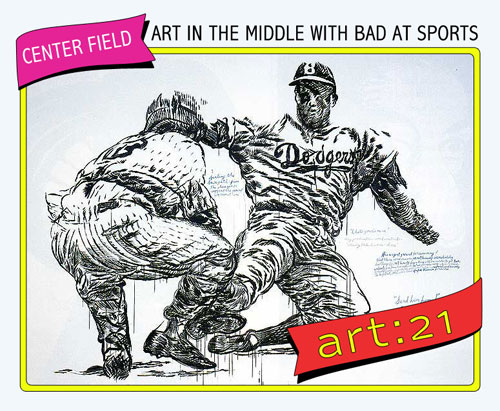
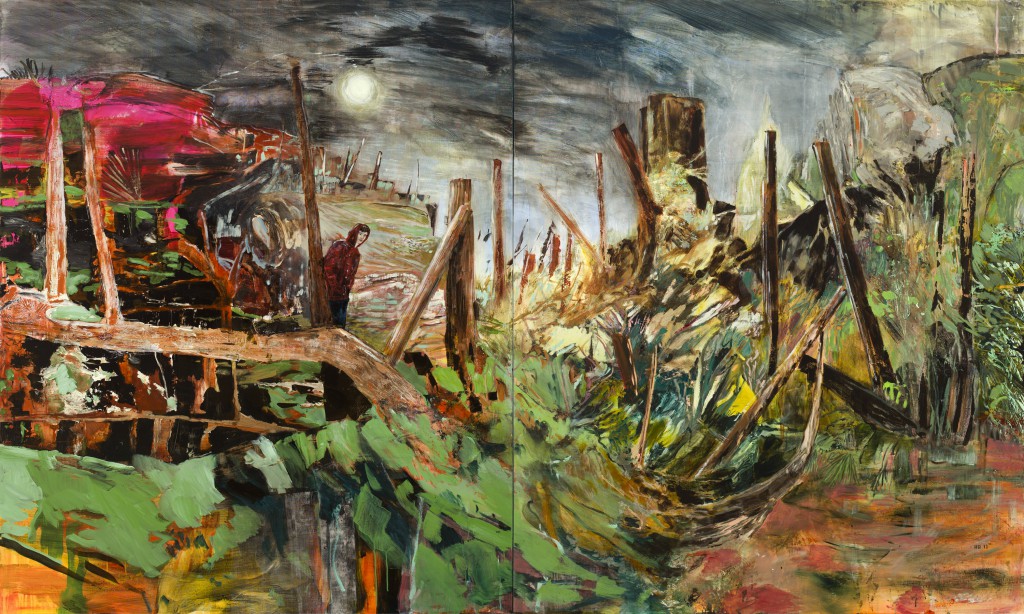

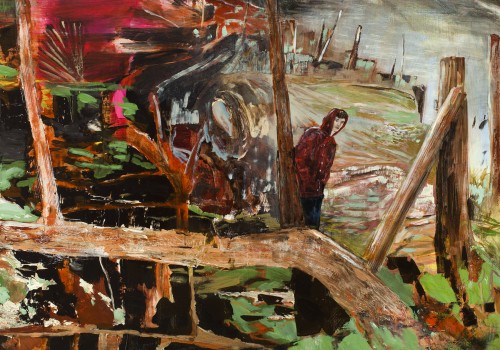
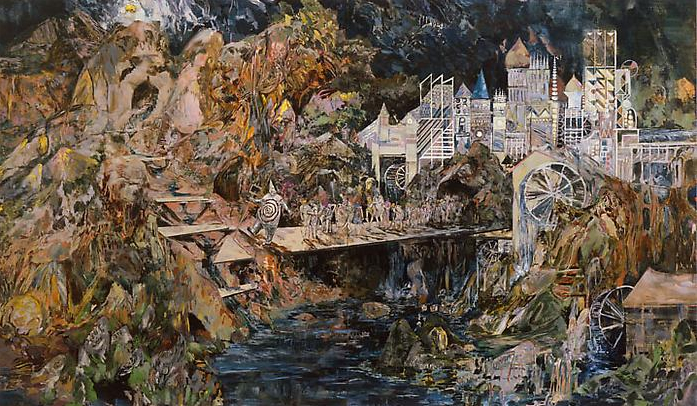
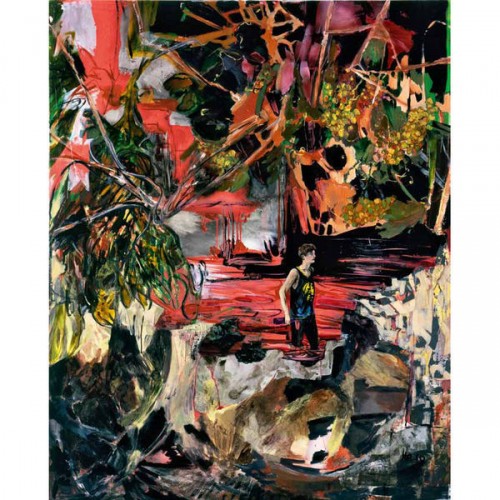
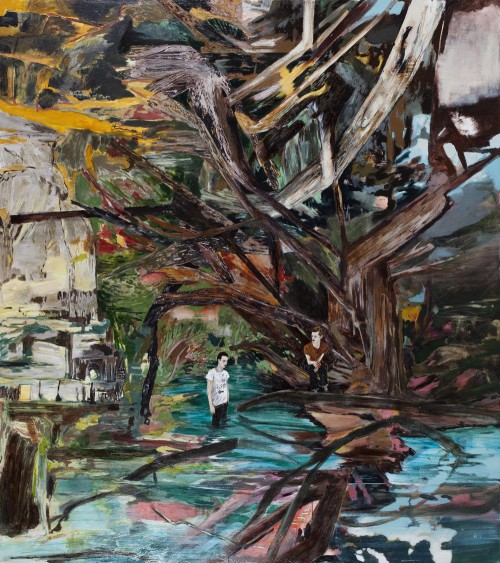
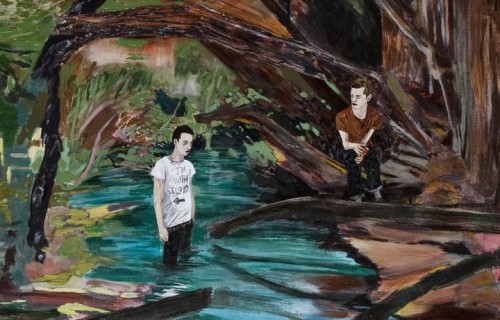
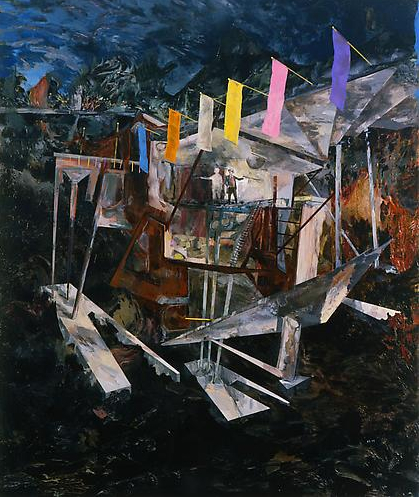




Pingback: Painting In The Haunted Spice Factory: Hernan Bas Talks About His Work | USA Press
Pingback: Hernan Bas on Painting Aristocratic, Queer Life in 1920s London | TheHostNovel